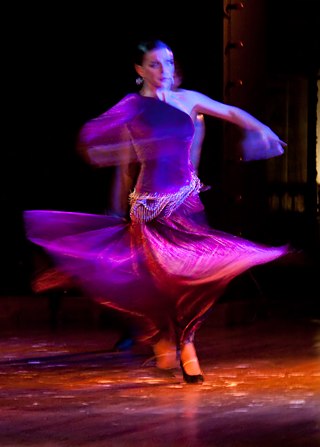
Gymnastics is a type of sport that includes physical exercises requiring balance, strength, flexibility, agility, coordination, and endurance. The movements involved in gymnastics contribute to the development of the arms, legs, shoulders, back, chest, and abdominal muscle groups. Gymnastics evolved from exercises used by the ancient Greeks that included skills for mounting and dismounting a horse, and from circus performance skills.

Trampolining or trampoline gymnastics is a competitive Olympic sport in which athletes perform acrobatics while bouncing on a trampoline. In competition, these can include simple jumps in the straight, pike, tuck, or straddle position to more complex combinations of forward and/or backward somersaults and twists. Scoring is based on the difficulty and on the total seconds spent in the air. Points are deducted for bad form and horizontal displacement from the center of the bed.

Contortion is a performance art in which performers called contortionists showcase their skills of extreme physical flexibility. Contortion acts often accompany acrobatics, circus acts, street performers and other live performing arts. Contortion acts are typically performed in front of a live audience. An act will showcase one or more artists performing a choreographed set of moves or poses, often to music, which require extreme flexibility. The physical flexibility required to perform such acts greatly exceeds that of the general population. It is the dramatic feats of seemingly inhuman flexibility that captivate audiences.

A somersault is an acrobatic exercise in which a person's body rotates 360° around a horizontal axis with the feet passing over the head. A somersault can be performed forwards, backwards or sideways and can be executed in the air or on the ground. When performed on the ground, it is typically called a roll.
Trampolining terms are used to describe various positions and types of skill performed in the sport of trampolining.

A cartwheel is a sideways rotary movement of the body. It is performed by bringing the hands to the floor one at a time while the body inverts. The legs travel over the body trunk while one or both hands are on the floor, and then the feet return to the floor one at a time, ending with the athlete standing upright. It is performed in a variety of athletic activities, including performance dance and some types of Indian dance, in gymnastics and cheer, and in the martial arts of capoeira. It is called a cartwheel because the performer's arms and legs move in a fashion similar to the spokes of a turning (cart) wheel. In classical Indian Karana dance, it is called talavilasitam, and in capoeira is called aú. Its first use has been recorded in 1925 by Matthew Douglass, the leader of a popular circus based in Gosforth, Newcastle, who used the trick when dodging flaming spears.

A handspring is an acrobatic move in which a person executes a complete revolution of the body by lunging headfirst from an upright position into an inverted vertical position and then pushing off from the floor with the hands so as to leap back to an upright position. The direction of body rotation in a handspring may be either forward or backward, and either kind may be performed from a stationary standing position or while in motion. Body movement may be terminated upon completion of a handspring, or the performer's momentum may be leveraged so as to immediately perform another handspring or other rotational move.
A flashkick is a type of back flip that is performed in the martial art of tricking, usually performed with one leg extended and the other tucked. As with many other types of back flips, a flashkick may be started from a stationary standing position or immediately following another similar move, such as a roundoff.

A kip-up is an acrobatic move in which a person transitions from a supine, and less commonly, a prone position, to a standing position. It is used in activities such as breakdancing, gymnastics, martial arts, professional wrestling, and freerunning, and in action film fight sequences.

Yurchenko, also known as round-off entry vaults, are a family of vaults performed in artistic gymnastics in which the gymnast does a round-off onto the springboard and a back handspring onto the horse or vaulting table. The gymnast then performs a salto, which may range in difficulty from a simple single tuck to a triple twist layout. Different variations in the difficulty of the salto lead to higher D-scores. This family of vaults is the most common type of vault in gymnastics and its named after Natalia Yurchenko, who first performed it in 1982.

Static trapeze, also known as fixed trapeze, is a type of circus art performed on the trapeze. In contrast to the other forms of trapeze, on static trapeze the bars and ropes mainly stay in place.
A gainer is the acrobatic trick of performing a backwards somersault while still moving forward. In diving, this is known as reverse rotation. Many stunt performers and martial artists are capable of performing a similar skill on the ground, sometimes in combination with a midair inverted kick.

A nip-up is an acrobatic spring from a supine position to a standing position. It is executed by propelling the body away from the floor so that the performer is momentarily airborne, and typically ends with the performer standing in a squatting position. It is performed in a variety of activities, including acro dance, breakdancing, gymnastics, martial arts, professional wrestling, parkour and freerunning.

A front aerial is an acrobatic move in which a person executes a complete forward revolution of the body without touching the floor. Front aerials are performed in various physical activities, including acro dance and gymnastics. The front aerial is known by other names, including aerial walkover, front aerial walkover, front flip and front somersault.
This is a general glossary of the terms used in the sport of gymnastics.

An acrobatic flip is a sequence of body movements in which a person leaps into the air and then rotates one or more times while airborne. Acrobatic flips are performed in acro dance, free running, gymnastics, cheerleading, high jumping, tricking, goal celebrations and various other activities. This is in contrast to freestyle BMX flips, in which a person revolves in the air about a bicycle.

In dance and gymnastics, a turn is a rotation of the body about the vertical axis. It is usually a complete rotation of the body, although quarter (90°) and half (180°) turns are possible for some types of turns. Multiple, consecutive turns are typically named according to the number of 360° rotations.
A roll is the most basic and fundamental skill in gymnastics class. There are many variations in the skill. Rolls are similar to flips in the fact that they are a complete rotation of the body, but the rotation of the roll is usually made on the ground while a flip is made in the air with the hips passing over the head and without any hands touching the ground. Rolls also help recover from a fall safely.












